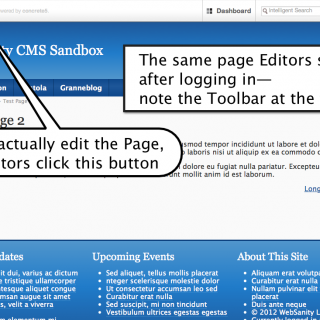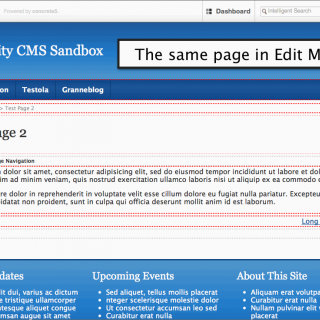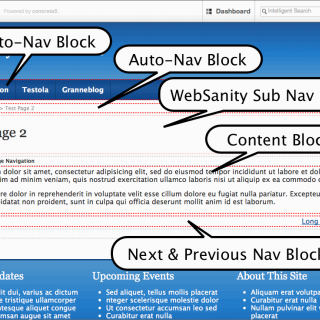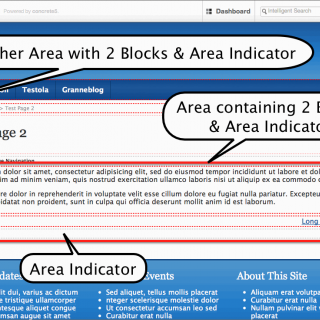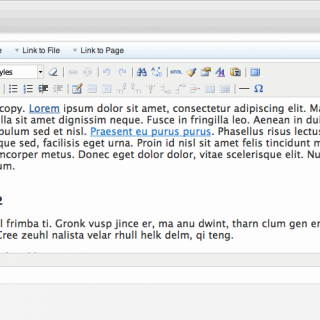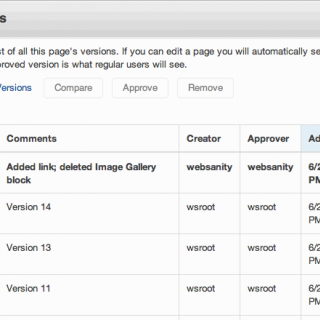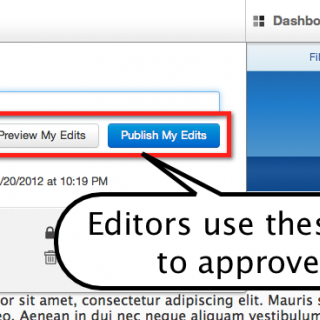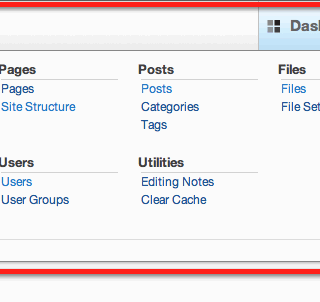On this page…
Time to learn a few new terms
As you read this manual—and ask WebSanity for help!—knowledge of these terms will help greatly so that we’re all talking about the same things.
Editor View
When an editor logs in (discussed in Logging In), they will see that the Toolbar appears at the top of every Page, as you can see in the figure.
The Toolbar allows the editor to visit the Dashboard to configure the website and switch the page into Edit Mode in order to actually alter the contents of the page.
Edit Mode
When a page is in Edit Mode, the following happens:
- editors can't use site navigation on that Page
- dotted outlines appear around editable sections of the Page
- editors can change the content of the Page by editing Blocks
- editors can add, remove, or move Blocks of content
Where editing takes place
When you edit your site, you're actually editing Blocks, which are inside Areas, which are determined by Page Types. Confused? Read on!
Blocks
Blocks make up the chunks of editable content on Pages, with names like Content Block, Image Block, and YouTube Video Block. Blocks have red dotted lines around them, as you can see in the figure.
NOTE: Some Blocks have black dotted lines around them. Those are special Stacks that have been placed on the page. Stacks are discussed later in this manual.
The WebSanity CMS has a wide selection of Blocks for you to use. If you need others, WebSanity can add or create them for you.
Most of the time, when editing a Page, you’re really editing its Blocks. You’ll learn more about Blocks and editing later in this manual.
Areas
Blocks are contained inside Areas, which are pre-defined sections of a Page. Areas have names like Body, Sidebar, Featured Images, and Footer.
You can see Area Indicators at the bottom of one or more Blocks contained within an Area—words like “Add to” and then the name of the Area, with the Indicator surrounded by gray dotted lines, as in the figure.
Some Blocks may not be available in all Areas. For instance, one Area might allow the insertion of Content Blocks, Image Blocks, and Google Map Blocks, while another Area might only allow the insertion of Google Map Blocks.
Page Types
Blocks are within Areas, and Areas are defined by Page Types. When WebSanity develops your website with you, we will help …
- come up with your list of Page Types,
- pre-populate those Page Types with appropriate Areas, and
- determine which Blocks are allowed inside those Areas.
When you add a Page, you select a Page Type.
The Page Type determines:
- The basic layout of the Page
- What Areas appear on the Page
- The starting content on the Page
Some Page Types are general purpose, with names like One Column, Two Column, & Three Column. Other Page Types have specific purposes, with names like Product Detail, Staff Bio, and Animal Detail.
You can change a Page Type after you create a Page. However, only WebSanity can add, edit, or delete Page Types, so ask us if you need those tasks done.
Editing & management tools
As an editor, you have a variety of tools available to you to change the content on your site and control how your site looks & works. Let's review the following:
- The Toolbar
- WYSIWYG Editor
- Versions
- Approved
- Dashboard
The Toolbar
The Toolbar allows you to access Page editing options and the Dashboard that allows you to upload files and manage your website.
WYSIWYG editor
WYSIWYG stands for “What You See Is What You Get”. You'll use it to edit content in many Blocks.
The WYSIWYG editor looks a lot like a word processor such as Microsoft Word or OpenOffice.org. It looks like you're typing in plain English, but you're actually generating HTML behind the scenes.
The WYSIWYG editor is covered in depth in Appendix: The WYSIWYG Editor.
Versions
Each time you edit and save a Page, a new version is created. Old versions are saved so you can revert to them if necessary. You can even compare versions to see what’s changed.
Read more about this handy feature in Versions, later in this manual.
Approved
When you publish a Page to go live so the public can see your changes, you Approve it.
You can edit Pages as long as you’d like and as many times as you’d like before publishing them.
Dashboard
Editors and Administrators can access the Dashboard, where they can administer the website.
Different groups of editors will see different buttons on the Dashboard.
